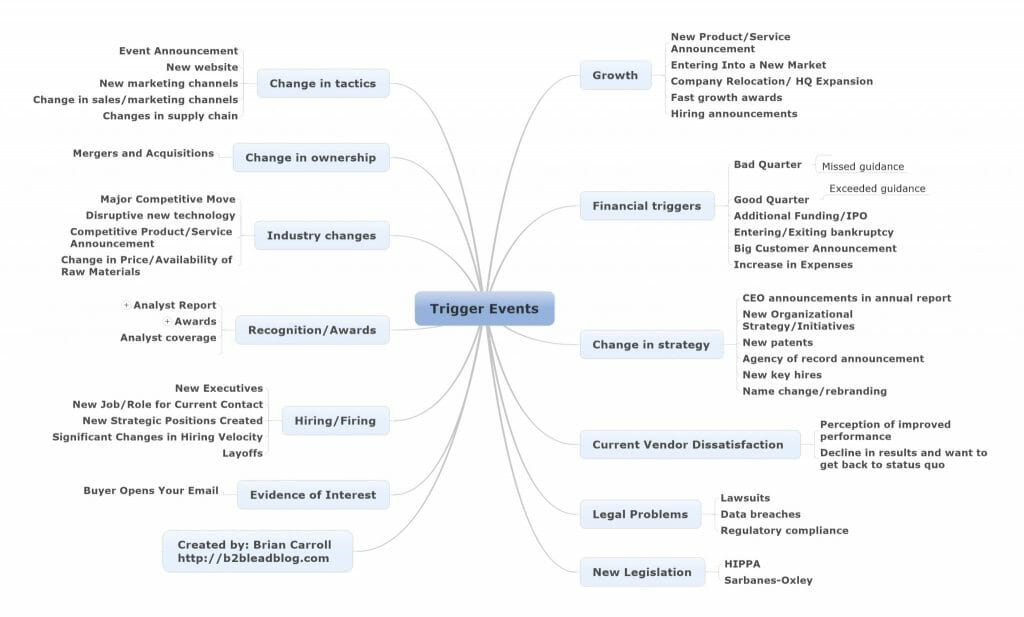No, it’s not another buzzword. A sales trigger event is crucial because it distinguishes hot leads from cold ones. It gives you the opportunity to maximize the effectiveness of your sales pitch and help you close a deal.
As a salesperson, timing is everything. Selling your product or service at the optimal time can be the difference between making a minor profit or major bank. In a competitive market, it’s paramount that you incorporate trigger events in your sales process to keep the upper hand and make your sales pitch at the best possible moment. Trigger events help with sales prospecting by indicating the best time to sell your product or service, and can help you customize your outreach.
Boost your sales prospecting with Crunchbase Pro — try it free today
What is a sales trigger event?
A sales trigger event or a buy signal is an occurrence that leads to a sales opportunity. Some of the most common trigger events for business include new funding rounds, mergers and acquisitions, hiring C-level staff, company layoffs, and restructuring personnel. Mergers and acquisitions, increases and decreases in investments, and expansion of a company through new hires or office locations are additional examples of trigger events.
Most changes can be trigger events. Founding a company, acquiring a new customer, losing a customer, offering a new product, and letting go of an existing vendor can all indicate pathways to change and opportunities for sales. Taking on more of a broad point of view, any industry changes, competitor adjustments, awards or special events are trigger events.
Why do trigger events matter?
Company changes offer a window of opportunity to make a sale – one you should take advantage of before it closes. If a company replaces its leadership, for instance, the new executives could be seeking a change and require RFPs as they re-evaluate spending on products and services they outsource. A company is primed, then, to be more open to working with new businesses, customers and investors.
Increases in investments, sales, staff, and office locations indicate a company is growing − meaning it likely has a greater amount of revenue coming in to spend on products and/or services.
When a business receives accolades or begins hosting special industry events, it’s garnering or seeking greater attention. This offers the perfect opportunity to pitch a product or service that could help the company keep its momentum. If a prospective lead just got upstaged by a competitor, it may drive them to seek alternatives that will help them outshine that rival. That’s where you come in, offering a product or service that can push that prospective lead to that next level.
10 ways to track sales trigger events
There are a multitude of ways to track trigger events, from online information to sales intelligence software. Here are 10 ways to keep track of the most important trigger events.
-
- Crunchbase alerts: Signing up to get information from Crunchbase can provide valuable data on a company’s investments, funding activity, hiring, and more. These signals can help you determine if a business has money to invest in your product or service. Any substantial funds that move in and/or out of a company will help you to identify the best time to pitch, or conversely when to wait for a more opportune time.
- Google alerts: Google allows you to set up alerts whenever a set search term is mentioned. Simply input the names of your potential leads. Then you’ll get an email when a business is mentioned in the news or anywhere on the web.
- Facebook & Twitter alerts: You can also set up alerts for Facebook and Twitter. In the millennial age, social media is sometimes the first channel where a business will post their breaking news. Being the first to know when a potential lead makes a big announcement or becomes a trending topic can give you a time advantage when it comes to making a pitch.
- LinkedIn alerts: LinkedIn also has a feature where you can set up alerts when jobs at a company are advertised. This can alert you to potential personnel changes. It’s a great initial foot in the door for a sales pitch.
- Social listening tools: There are a myriad of social listening tools out there that can help you identify when someone is talking about your business, or something that pertains to your business. A few well-known social listening tools are Sprout Social, Hootsuite, and Buffer, but there are plenty of options to choose from that can help you derive the specific insights and analytics you’re looking for.
- Industry Newsletters: Staying on top of industry news can sometimes be the best indicator of trigger events. Regularly check up on news relating to the industry you are targeting. Subscribing to sites such as Cision’s PR Newswire, Crunchbase News, and Crunchbase Daily can help you stay in the know on impactful events.
- Company press releases/blogs: Company press releases and blog announcements can be a great way to track important company updates. While you can stay up-to-date on press releases using PR Newswire and other PR sources, not all news is shared with distribution services. Sometimes the best place to find new information is on the company’s press page or blog.
- SEC filings: If you’re selling into a public company, financial statements known as SEC filings are submitted by the company to the U.S. Securities and Exchange Commission (SEC) and may be available online through the Electronic Data Gathering and Analysis and Retrieval system (EDGAR). These financial statements can help you decide if the company you’re trying to sell into is able to buy your product or service.
- Earnings calls: Another place to find financial information is on company earnings calls. Most companies allow individual investors to listen to the calls live, and make call recordings and transcriptions available via Seeking Alpha and other services.
- Email tracking: There are many intelligent sales tools available that can help you determine if you’re getting through to a prospect. Yesware, HubSpot, SalesLoft and many other providers allow insight into if your prospect opened your email, as well as additional metrics that can help you determine the appropropriate time and format for your next outreach.
Pro Tip: Try using the following Crunchbase lists to trigger and personalize your outreach:
How Crunchbase can help
Regularly monitoring a company’s activities can be time-consuming and waste valuable resources while also costing a lot of money. Crunchbase Pro can send you all of the important information you seek automatically.
With Crunchbase’s advanced search capabilities and customizable filters, you can quickly discover companies that match your ICP. You can then save your search and receive automatic updates if one of your target prospects raises funding, hires new leadership, is mentioned in the news, and more. You’ll also receive an alert if another company that matches your ICP and selected search filters is added to Crunchbase.


Generating a potential lead or re-engaging a cold lead is just the first step toward making a sale. Crunchbase can help narrow down your search to find the best leads for your business. The key to turning a lead into a sale is knowing when to sell your product or service, and how to personalize your outreach to get noticed. By identifying and tracking trigger events, you’ll be able to react to potential sales opportunities more quickly, and make your outreach resonate. Trigger events can help you close more deals and increase your likelihood of beating competitors to a new prospect.







